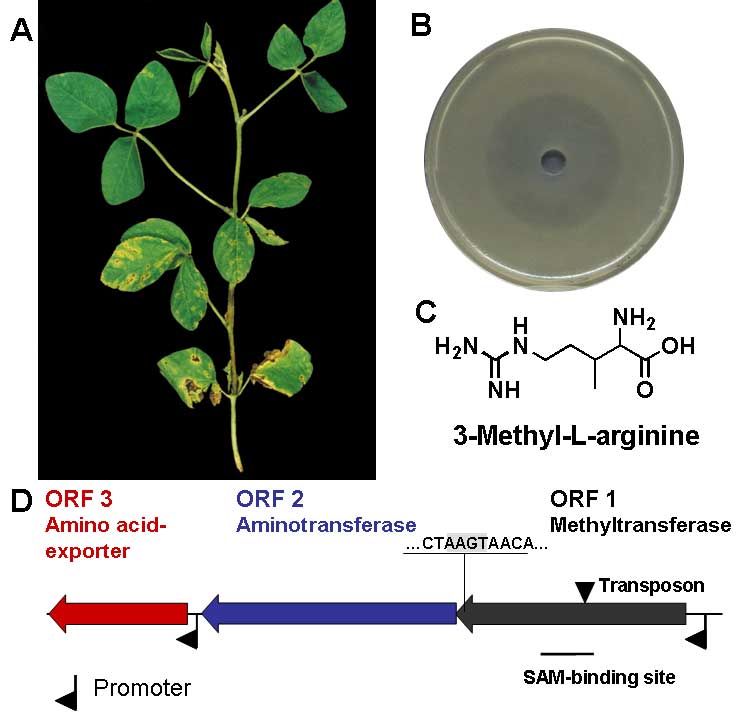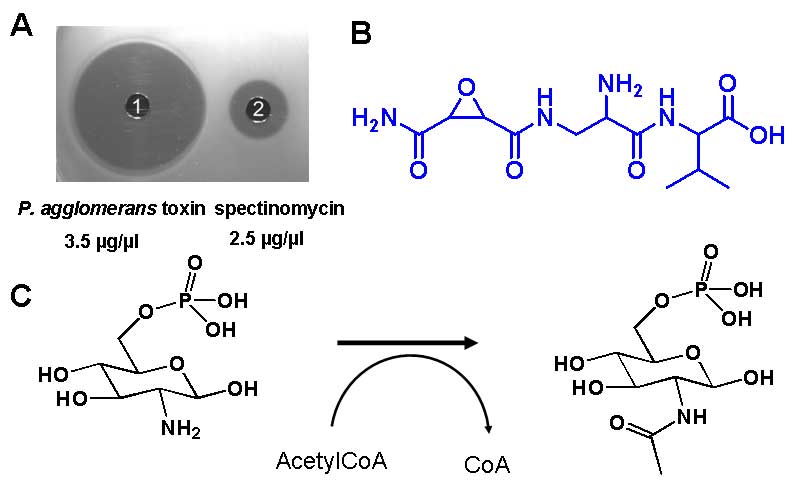Molecular basis of the biocontrol potential of epiphytes
In cooperation with Dr. Beate Völksch (Phytopathology, Friedrich Schiller University Jena) we intend to reveal the molecular basis of the biocontrol function of selected epiphytic microorganisms that protect their plant hosts such as soy bean against pathogenic infections.
3-Methylarginine a potent toxin from Pseudomonas syringae pv. syringae 22d/93
The epiphyte Pseudomonas syringae pv. syringae 22d/93 (Pss22d) produces the rare amino acid 3-methylarginine that is highly active against the closely related soybean pathogen Pseudomonas syringae pv. glycinea (Psg). Competing for the same habitat, Pss22d is a promising candidate for biocontrol of Psg. A trio of genes, a S-adenosylmethionine dependent methyltransferase, an aminotransferase and an amino acid exporter, is sufficient to produce 3-methylarginine.

Figure 1: A. Bacterial blight of soy bean. B. Inhibition of the phytopathogen Pseudomonas syringae pv. glycinea by 3-methylarginine. C. Structure of 3-methylarginine produced by the epiphyte Pseudomonas syringae pv. syringae 93/22d. D. 3-Methylarginine gene cluster
S. B. Braun, B. Völksch, J. Nüske, D. Spiteller, 3-Methylarginine from Pseudomonas syringae pv. syringae 22d/93 suppresses the bacterial blight caused by its close relative Pseudomonas syringae pv. glycinea. ChemBioChem 2008, 9, 1913-1920.
S. D. Braun, J. Hofmann, A. Wensing, M. S. Ullrich, H. Weingart, B. Völksch, D. Spiteller, Identification of the biosynthetic gene cluster of 3-methylarginine, a toxin produced by Pseudomonas syringae pv. syringae 22d/93, Appl. Environ. Microbiol., 2010, 76, 2500-2508.
Herbicolin I - 2-Amino-3-(oxirane-2,3-dicarboxamido)-propanoyl-valine from Pantoea agglomerans
The epiphyte Pantoea agglomerans 48b/90, which has been isolated from soybean leaves, belongs to Enterobacteriaceae as does the plant pathogen Erwinia amylovora, which causes fire blight on rosaceous plants such as apple and leads to severe economic losses. Since P. agglomerans efficiently antagonizes phytopathogenic bacteria, the strain P. agglomerans C9-1 is used as a biocontrol agent (BlightBan C9-1). Using bioassay-guided isolation a peptide antibiotic that is highly active against various phytopathogenic bacteria, in particular E. amylovora was obtained. We identified the compound as 2-amino-3-(oxirane-2,3-dicarbox-amido)-propanoyl-valine using HR-ESI-MS and NMR.

Figure 2: A. Inhibition of the pathogen Erwinia amylovora by a toxin from Pantoea agglomerans, B. Structure of the toxin: 2-amino-3-(oxirane-2,3-dicarboxamido)-propanoyl-valine, C. Inhibition of the glucosamine-6-phosphate synthase (GlmS), a key enzyme of the bacterial cell wall biosynthesis, by 2-amino-3-(oxirane-2,3-dicarboxamido)-propanoyl-valine
U. A. Sammer, B. Völksch, U. Möllmann, M. Schmidtke, P. Spiteller, M. Spiteller, D. Spiteller, 2-Amino-3-(oxirane-2,3-dicarboxamido)-propanoyl-valine, an effective peptide antibiotic from the epiphyte Pantoea agglomerans 48b/90, Appl. Environ. Microbiol., 2009, 75, 7710-7717.
